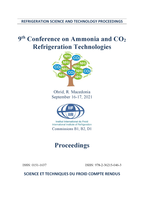
Summary
Large refrigeration systems are commonly used on FPSOs (floating production, storage and offloading facilities) during natural gas treatment. Despite storing thousands of tonnes of liquid hydrocarbons on board, FPSO owners usually specify a non-flammable refrigerant, and most current applications use R-134a. High- GWP refrigerants are being phased out, and low-GWP alternatives include propane, ammonia, HFOs and CO2. Propane and ammonia are not well accepted offshore, and the future of HFOs is uncertain. CO2 systems with condensing temperatures near ambient, especially in tropical climates, become supercritical, with high operating pressure and low efficiency. However, FPSOs mainly operate in deep water, where cold water below +20 deg.C, is available at depths of 100-200 m, even at the equator. Use of cold seawater for cooling allows CO2 systems to operate subcritical, and an optimised CO2 refrigeration system can have lower power, smaller footprint and lower weight than a similar optimised R-134a system.
Available documents
Format PDF
Pages: 7
Available
Public price
20 €
Member price*
Free
* Best rate depending on membership category (see the detailed benefits of individual and corporate memberships).
Details
- Original title: Green refrigeration for FPSOs.
- Record ID : 30028953
- Languages: English
- Source: 9th IIR Conference on Ammonia and CO2 Refrigeration Technologies. Proceedings: Ohrid, North Macedonia, 16-17 September, 2021
- Publication date: 2021/09/16
- DOI: http://dx.doi.org/10.18462/iir.nh3-co2.2021.0016
Links
See other articles from the proceedings (31)
See the conference proceedings
Indexing
-
Themes:
Gas processing and purification;
CO2 - Keywords: Natural gas; Treatment; Tank; Sea transport; Storage; Review; CO2; R744
-
MEMBRANE/CRYOGENIC HYBRID SYSTEMS FOR HELIUM PU...
- Author(s) : CHOE J. S.
- Date : 1988/03/14
- Languages : English
View record
-
DEVELOPMENT OF GASEOUS PERMEATION MEMBRANES ADA...
- Author(s) : DESCHAMPS A., DICK R., LECOMTE C.
- Date : 1989
- Languages : English
- Formats : PDF
View record
-
Application of a mixed refrigerant cycle for hy...
- Author(s) : LISS W., WURM J., SCHUSTR P., et al.
- Date : 2004/04/27
- Languages : English
- Source: Cryogenics 2004. Proceedings of the 8th Cryogenics Conference
- Formats : PDF
View record
-
Separation of ultra high purity helium from nat...
- Author(s) : KNAEBEL K. S., REINHOLD H.
- Date : 1998/05/24
- Languages : English
- Source: Fundamentals of adsorption - FOA6. Proceedings of the Sixth International Conference.
View record
-
DEVELOPMENT AND APPLICATION OF THE CONTROLLED F...
- Author(s) : HAUT R. C., DENTON R. D., THOMAS E. R.
- Date : 1988
- Languages : English
View record
